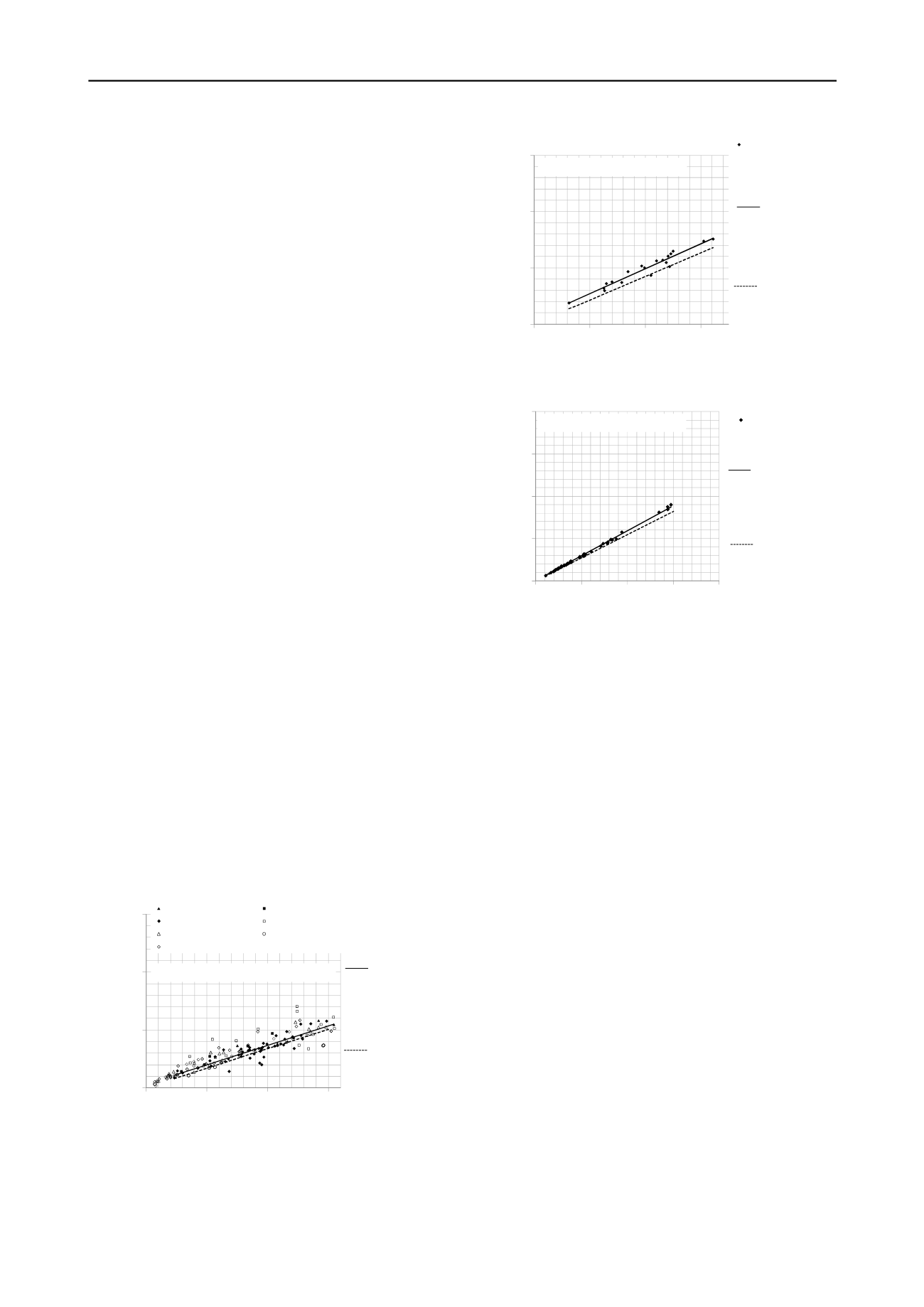
428
Proceedings of the 18
th
International Conference on Soil Mechanics and Geotechnical Engineering, Paris 2013
stresses (<50 kPa) as the failure envelope curves towards origin
(see Figure 1b).
4 VALIDATION OF THE PROPOSED RELATIONSHIPS
The test results from the three test series from the Great Belt
(GB), Fehmarnbelt (Fixed Link) (FB) and Esbjerg Habour (EB)
ground investigations are shown in Figures 8-10. The figures
show the failure points for each shear stage for all the tested
specimens in a plot of shear stress t against mean effective
stress s'. For each test series the best-fit line through the data
points is shown, and for comparison the cautiously estimated
effective strength envelope is also shown (dashed line). The
estimated strength envelope is based on the estimated angle of
shearing resistance
φ
'
oc
found from eq. 5-6 on the basis of the
mean value of I
p
for the tested clays, and the effective cohesion
c'
oc
determined from eq. 13. c
u
has been assumed equal to the
mean shear stress t
fm
at failure, as derived from the best-fit
regression line through the failure points.
It is observed that the estimated strength envelope in all
cases provides a cautious estimate of the strength of the tested
clays within the given stress intervals.
5 CONCLUSION
Simple correlations between the plasticity index and the drained
peak strength parameters in terms of
φ
'
oc
and c'
oc
have been
proposed on the basis of a comprehensive database of triaxial
compression tests on undisturbed overconsolidated Danish clays
of very low to extremely high plasticity. The proposed
correlations gives cautious lower bound values of the drained
strength parameters, which can be used as a first approximation
for use in preliminary design of geotechnical structures.
Furthermore, the correlations can be used to evaluate the results
of laboratory effective strength tests, and as a mean to assess
how well these results represent the entire soil mass at a given
site when viewed in connection to the variations of the index
properties in the soil mass.
The authors however believe that the proposed correlations
should only be used in cases where time and cost constraints do
not allow for actual effective strength tests to be carried out. In
most other cases the use of effective strength tests will provide a
much more reliable and cost effective estimate of the strength
properties of the soil in question.
Figure 8. Failure points for high plasticity clays (50%<I
P
<170%) shown
in a t,s' plot
Figure 9. Failure points for mica clay (20<I
P
<43%) shown in a t,s' plot
Figure 10. Failure points for clay till (4<I
P
<7%) shown in a t,s' plot
6 ACKNOWLEDGEMENTS
The authors would like to acknowledge the support and work
done by B. Knudsen (previously The Danish Geotechnical
Institute) on the subject.
Data have been made available by Femern A/S
(
), but findings and conclusions expressed in
this paper do not necessarily reflect the views of Femern A/S.
7 REFERENCES
Brooker E. W. and Ireland H.O. 1965. Earth pressure at rest related to
stress history.
Canadian geotechnical journal
, vol. 2 no. 1, pp.1-15
Burland J. 1990. On the Compressibility and Shear Strength of Natural
Clays.
Géotechnique.
vol. 40 no. 3, pp 329-378.
Fehmarnbelt (Fixed Link) 2011.
Ground Investigation Report
. GDR
00.1-001 with additional data from GEO (2011) GDR 18.0-004,
Advanced Laboratory Testing, Glacial Deposits and GDR 18.0-005,
Advanced Laboratory Testing, Clays of Palaeogene Origin.
Knudsen B. (1981). Plastisk ler – Geoteknisk design. Unpublished
Internal report (in Danish).
The Danish Geotechnical Institute
.
Ladd C.C. et al. 1977. Stress-deformation and strength characteristics.
Proc. 9th. Int. conf. soil mech. and found
.
Eng
. pp. 421-494.
Leroueil S. and Vaughan P. R. 1990. The general and congruent effects
of structure in natural soils and weak rocks.
Géotechnique
, vol. 40
no. 3, pp 467-488.
Jacobsen M. 1970. Strength and deformation properties of
preconsolidated moraine clay.
The Danish Geotechnical Institute
.
Bulletin 27. pp 21-45.
Skempton A. W. 1977. Slope stability of cutting in brown London clay.
7th ICSMFE
. Tokyo vol. 3, pp. 261-270.
Stark, T.D. and H. T. Eid. 1997. Slope stability analysis in stiff fissured
clays.
JGGE
, pp 335-343.
Terzaghi et al. 1996.
Soil Mechanics in engineering practice
. 3rd. ed.
John Wiley & Sons, New York
0
200
400
600
0
200
400
600
Shear stress t (kPa)
Mean effective stress s' (kPa)
FB - Holmehus
FB - Ølst
FB - Røsnes
Olddata - lillebælt
Olddata - Septarianclay Olddata - Holmehus
Olddata - other
Mean -
FB data:
t
fm
=0.337·s'
f
+13
φ
'
oc
=19.7deg.
c'=14kPa
MeanFB data:n=48, R
2
=0.79, SE
y
=21
Estimated
(Avr. I
P
=114%):
t
f
=0.303·s'
f
+0.1·t
fm
φ
'
oc
=17.6deg.
c'=0.1·c
u
0
200
400
600
0
200
400
600
Shear stress t (kPa)
Mean effective stress s' (kPa)
EB (2011) - Mica clay
Mean -
EB data:
t
fm
=0.444·s'
f
+19
φ
'
oc
=26.4 deg.
c'=21kPa
Mean:n=19, R
2
=0.94, SE
y
=15
Estimated
(Avr. I
P
=36%):
t
f
=0.378·s'
f
+0.1·t
fm
φ
'
oc
=22.2deg.
c'=0.1·c
u
0
500
1000
1500
2000
0
500 1000 1500 2000
Shear stress t (kPa)
Mean effective stress s' (kPa)
GB - clay till
(1992)
Mean:
t
fm
=0.592·s'
f
φ
'
oc
=36.3 deg.
c'=0kPa
Mean:n=45, R
2
=1.00, SE
y
=10
Estimated
(Avr. I
P
=6%):
t
f
=0.546·s'
f
φ
'
oc
=33.1 deg.
c'=0kPa


